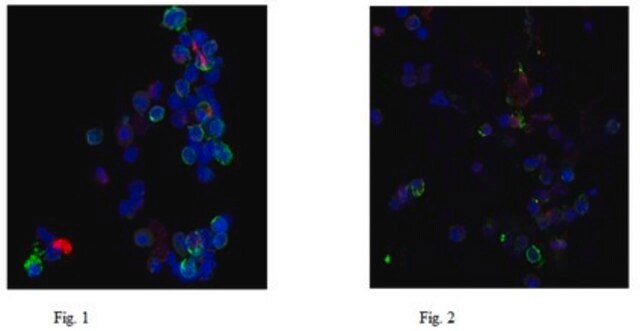MABT1240
Anti-Cathepsin G Antibody, clone AHN-11, Ascites Free
clone AHN-11, from mouse
Sinonimo/i:
Cathepsin G, CatG, CG
About This Item
Prodotti consigliati
Origine biologica
mouse
Livello qualitativo
Forma dell’anticorpo
purified immunoglobulin
Tipo di anticorpo
primary antibodies
Clone
AHN-11, monoclonal
Reattività contro le specie
human
tecniche
ELISA: suitable
immunocytochemistry: suitable
radioimmunoassay: suitable
western blot: suitable
Isotipo
IgG2aκ
N° accesso NCBI
N° accesso UniProt
modifica post-traduzionali bersaglio
unmodified
Informazioni sul gene
human ... CTSG(1511)
Descrizione generale
Specificità
Immunogeno
Applicazioni
Cell Structure
Inflammation & Autoimmune Mechanisms
Immunocytochemistry Analysis: Clone AHN-11 hybridoma culture supernatant immunostained ethanol-fixed human neutrophils, but not other peripheral blood cells, including platelets, lymphocytes, and eosinophils. Faint immunostaining of some monocytes was occasionally detected (Skubitz, K.M., et al. (1989). J. Leukoc. Biol. 46(2):109-118).
ELISA Analysis: A representative lot captured cathepsin G from human neutrophil granule extract. The captured cathepsin G served to detect the presence of serum cathepsin G autoantibody levels in patients serum samples (Ellerbroek, P.M., et al. (1994). J. Clin. Pathol. 47(3):257-262).
Radioimmunoassay Analysis: Clone AHN-11 hybridoma culture supernatant bound to well surface coated with dried human neutrophils, but not platelets or erythrocytes by solid-phase radioimmunoassay (Skubitz, K.M., et al. (1989). J. Leukoc. Biol. 46(2):109-118).
Radioimmunoassay Analysis: Clone AHN-11 hybridoma culture supernatant bound to well surface coated with content of primary granule, but not secondary granule, plasma membrane, or cytoplasm fraction from neutrophils by solid-phase radioimmunoassay (Skubitz, K.M., et al. (1989). J. Leukoc. Biol. 46(2):109-118).
Radioimmunoassay Analysis: Clone AHN-11 hybridoma culture supernatant reacted with purified human cathepsin G, but not elastase, EPO, esterase N, proteinase 3, plamin, kallidrein, lactoferrin, MBP, or thrombin by solid-phase radioimmunoassay (Skubitz, K.M., et al. (1989). J. Leukoc. Biol. 46(2):109-118).
Qualità
Immunocytochemistry Analysis: A 1:200 dilution of this antibody detected Cathepsin G in HL60 human promyelocytic leukemia cells.
Descrizione del bersaglio
Linkage
Stato fisico
Stoccaggio e stabilità
Altre note
Esclusione di responsabilità
Non trovi il prodotto giusto?
Prova il nostro Motore di ricerca dei prodotti.
Codice della classe di stoccaggio
12 - Non Combustible Liquids
Classe di pericolosità dell'acqua (WGK)
WGK 1
Punto d’infiammabilità (°F)
Not applicable
Punto d’infiammabilità (°C)
Not applicable
Certificati d'analisi (COA)
Cerca il Certificati d'analisi (COA) digitando il numero di lotto/batch corrispondente. I numeri di lotto o di batch sono stampati sull'etichetta dei prodotti dopo la parola ‘Lotto’ o ‘Batch’.
Possiedi già questo prodotto?
I documenti relativi ai prodotti acquistati recentemente sono disponibili nell’Archivio dei documenti.
Il team dei nostri ricercatori vanta grande esperienza in tutte le aree della ricerca quali Life Science, scienza dei materiali, sintesi chimica, cromatografia, discipline analitiche, ecc..
Contatta l'Assistenza Tecnica.